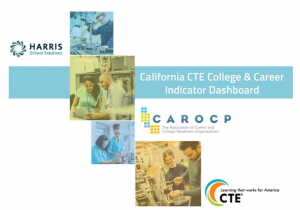This post is written by Harris School Solutions, a Diamond Level sponsor of the 2017 Advance CTE Spring Meeting.
As we draw near to the end of another school year, we should be asking ourselves, “Have we prepared this  year’s graduates to really be ‘college and career ready?’” To answer that question, we first must decide what, exactly, that phrase really means.
year’s graduates to really be ‘college and career ready?’” To answer that question, we first must decide what, exactly, that phrase really means.
Nearly every state in the nation is on a fast and furious quest to answer this question. College and Career Indicators (CCI) have emerged, as each state is defining various criteria that can be measured to validate “college and career readiness.” In today’s world of data crunching, this phrase should not be just a subjective evaluation; it must be quantifiable, based on specific and measurable student outcomes.
Some examples of CCI are more easily measured. Business internships give students real-world work  experience. Practical-skill attainment based on robust CTE Programs of Study can lead to increased student engagement. Industry credentials can be earned before a student graduates from high school.
experience. Practical-skill attainment based on robust CTE Programs of Study can lead to increased student engagement. Industry credentials can be earned before a student graduates from high school.
However, one of the most highly sought after CCIs remains elusive and difficult to define: CTE completion. While everyone wants to claim their students have “completed” a career pathway or program of study, what exactly does this mean? Some states define it by the number of hours a student is enrolled in a given pathway. Others base it on the amount of curriculum completed, where 70 percent is often a universally accepted threshold of proficiency.
CTE completion rates are complicated by the fact that different states offer CTE programs during different intervals of secondary education. High schools that specialize in CTE often provide three- or four-year programs of study, where students can accumulate 360-400 hours of concentrated CTE study per year. In traditional high schools, students may take a CTE course for only two or three hours per week in a given semester, accumulating, on average, 180 hours of study. Some practitioners feel it’s important to distinguish between enrollment duration and attendance hours. If a student is absent for two weeks, she potentially could lose 30 or more hours of seat time, thus affecting her ability to “complete.”
Regardless, if our quest is to measure whether a student is truly “college and career ready,” then expressing these various metrics in a universal dashboard is critical. Though the goal of consensus may be ambitious, aggregating data to share CTE outcomes is nonetheless a necessity for objective comparison and subsequent improvement. Furthermore, interpreting the data to help key stakeholders – students and parents – understand the value of a CTE education will help students to realize the opportunity for high-skill, high-wage, high-demand careers.
California has taken the lead in creating a CTE College and Career Indicator Dashboard. The Association of Career and College Readiness Organizations (CAROCP) is trailblazing an initiative to define what deems a student to be “college and career ready.” What makes the California initiative impressive is that it is a grassroots movement; a group of 11 pilot sites have published the first edition of a California CCI Dashboard. They started with simple metrics, but have gained the attention of the California Department of Education. In fact, superintendents from across California recently marched into the State Capitol, armed with mobile devices, sharing evidence of CTE student success using the CCI Dashboard. The Senators loved it – and asked for more.
We know all students must be “college and career ready” by the time they graduate. By striving to utilize our CTE data in meaningful and productive ways, we can help others to realize the benefits that a CTE education has to offer today’s students in accomplishing that goal. But that o nly happens if we, as CTE educators, commit our time, resources, and energy to ensuring “college and career ready” stands for something more than just words – we must translate it into numbers.
nly happens if we, as CTE educators, commit our time, resources, and energy to ensuring “college and career ready” stands for something more than just words – we must translate it into numbers.
To learn more about how your state can collect and measure College and Career Indicators, please contact Kathy Ritch, Harris School Solutions, at kritch@harriscomputer.com.

